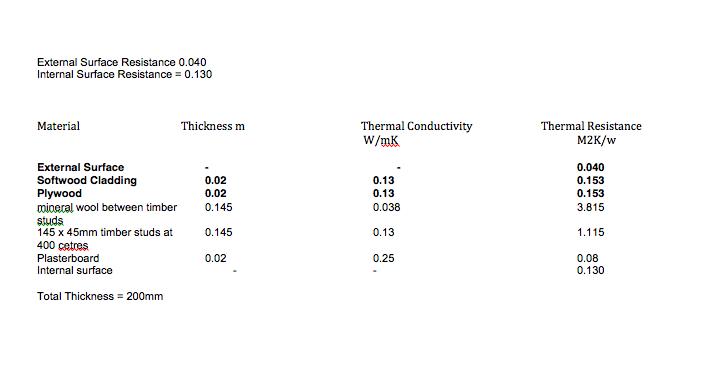Hello, I'm new to this forum and I appreciate your help !
I have a timber frame building, and below is what I've calculated so far for the u-value. I understand that by UK regulations you need the value to be 0.3 (?)
Cladding – Softwood
Thickness m Density Kg/m3 Conductivity W/mk
0.020 500 0.130
0.20/0.180 = 0.015
Plywood Sheathing
0.020 650 0.140
0.20/0.140 = 0.142
Mineral Wool
0.145 12 0.042
0.145/0.042 = 0.345
Timber studs ( 145*50 )
0.050 700 0.180
0.050/0.180 = 0.277
Plasterboard
0.015 600 0.160
0.015/0.160 = 0.093
Total 0.872
Thats the total of 0.872, which is way to high, where have I gone wrong with my calculations ? What you see is exactly what I have done, I didn't take into account the inside and outside thermal resistance.
Thank You
I have a timber frame building, and below is what I've calculated so far for the u-value. I understand that by UK regulations you need the value to be 0.3 (?)
Cladding – Softwood
Thickness m Density Kg/m3 Conductivity W/mk
0.020 500 0.130
0.20/0.180 = 0.015
Plywood Sheathing
0.020 650 0.140
0.20/0.140 = 0.142
Mineral Wool
0.145 12 0.042
0.145/0.042 = 0.345
Timber studs ( 145*50 )
0.050 700 0.180
0.050/0.180 = 0.277
Plasterboard
0.015 600 0.160
0.015/0.160 = 0.093
Total 0.872
Thats the total of 0.872, which is way to high, where have I gone wrong with my calculations ? What you see is exactly what I have done, I didn't take into account the inside and outside thermal resistance.
Thank You


